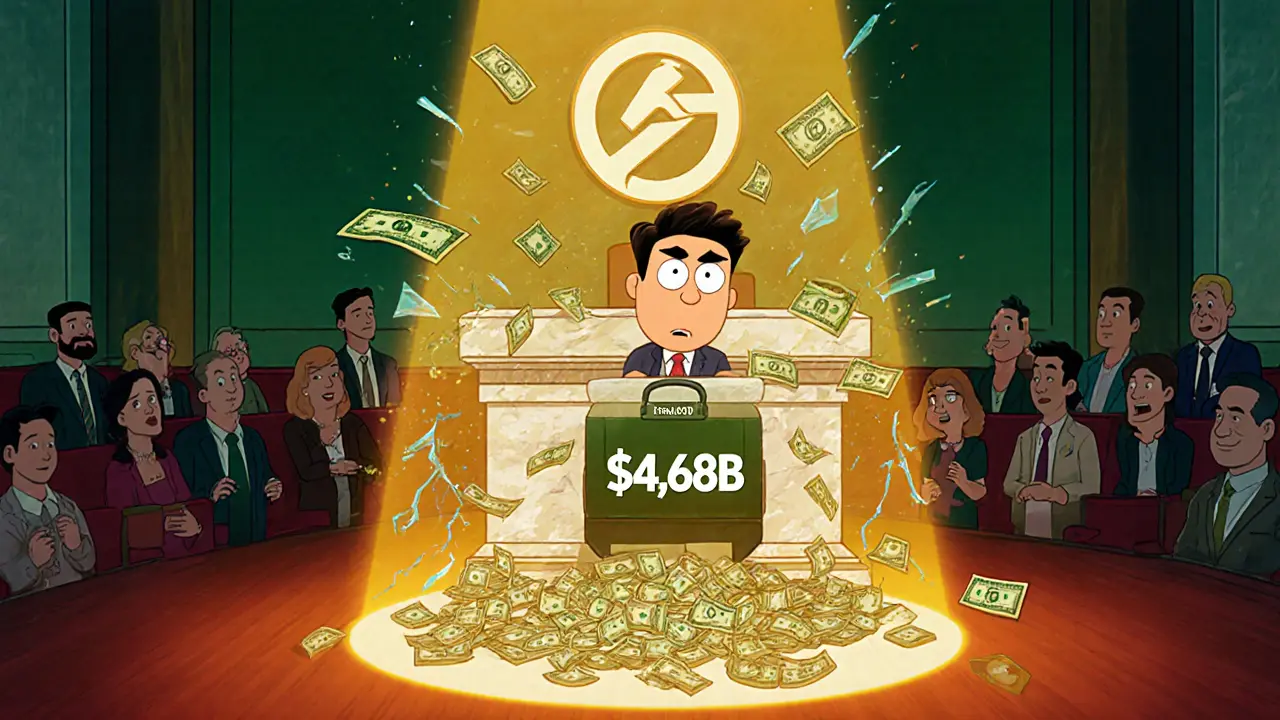Howey Test Calculator for Crypto Tokens
Token Classification Tool
Use this tool to estimate whether your token would likely be considered a security under SEC enforcement. Based on the Howey test criteria outlined in the article.
Howey Test Criteria: A token is a security if it involves: 1) investment of money, 2) common enterprise, and 3) expectation of profits from the efforts of others.
When the U.S. SEC the Securities and Exchange Commission, tasked with protecting investors and maintaining fair markets, unleashed a historic wave of penalties on the crypto sector in 2024, the industry felt the shock of a $4.68billion fine tally. That number dwarfs the $150million collected the year before and represents more than half of every crypto‑related fine the agency has ever levied. If you’re wondering why the numbers are so high, which firms bore the brunt, and what the fallout looks like for future projects, keep reading. This guide walks you through the headline‑grabbing cases, the policy shifts that made them possible, and the new enforcement playbook that’s emerging in 2025.
Why 2024 Became the Record‑Breaking Year
Three factors converged to push the fine total past the $4 billion mark:
- Leadership change - Former Chair Gary Gensler served from 2022 to early 2025 and drove a four‑fold increase in crypto penalties compared with the previous chair.
- Targeted high‑value cases - The SEC zeroed in on a handful of large, well‑funded entities rather than a broad spray of smaller lawsuits.
- Election‑year timing - Seventeen of the thirty‑three enforcement actions were filed in September and October, just before the November presidential election, signaling a political message as much as a legal one.
Even though the agency filed fewer total actions (33 versus 47 in 2023), the average penalty per case jumped dramatically, pushing the overall fine pool to historic levels.
The $4.68Billion Breakdown
The bulk of the $4.68billion came from a single, landmark settlement:
- Terraform Labs the South Korean‑run stablecoin issuer behind TerraUSD (UST) and its co‑founder Do Kwon was hit with a $4.68billion penalty for offering unregistered securities and misleading investors. This remains the largest ever SEC crypto penalty.
- Other notable fines included Ripple Labs $125million for selling XRP as an unregistered security (2021, still counted in the cumulative total) and Telegram $1.24billion for its 2019 unregistered token sale.
- Smaller yet still significant penalties-like the $102.64million case against the Barksdale brothers for a fraudulent ICO-added up to the remaining $0.9billion.
By the end of 2024, total SEC crypto penalties since 2013 topped $7.42billion, with the 2024 haul alone representing 63% of that sum.

How Enforcement Tactics Evolved
Under Gensler, the SEC leaned heavily on the Howey test-the legal framework that decides whether an asset is a security. The agency also started holding executives personally liable, a shift highlighted in the 2022 case against John and JonAtina Barksdale. Administrative proceedings, once a mainstay, fell by more than 50% in 2024, with the agency preferring court litigation for high‑profile targets.
After Gensler stepped down in January2025, Acting Chair Mark Uyeda announced a Crypto Task Force aimed at moving from reactive enforcement to clearer, forward‑looking guidance. The task force is led by Republican Commissioner Hester Pierce (nicknamed “Crypto Mom”) who advocates for a lighter‑touch regulatory approach. The new Crypto Task Force, together with the Cyber and Emerging Technologies Unit (CETU), trimmed attorney resources but promised more targeted action against outright fraud.
Key Cases That Shaped 2024’s Fine Landscape
| Entity | Penalty (USD) | Primary Violation |
|---|---|---|
| Terraform Labs | $4.68B | Unregistered securities & investor fraud |
| Ripple Labs | $125M | Sale of XRP as unregistered security |
| Telegram | $1.24B | Unregistered token offering (2019) |
| John & JonAtina Barksdale | $102.64M | Fraudulent ICO scheme |
| Binance | $4.3B (Justice Dept. settlement, linked to SEC scrutiny) | Money‑laundering & registration failures |
Notice how the table clusters the biggest fines around two themes: unregistered securities and outright fraud. The SEC’s focus on these two pillars has persisted from the early Telegram case to the recent Terraform Labs settlement.
The 2025 Pivot: From Penalties to Guidance
Early 2025 saw a noticeable softening:
- The Crypto Task Force released a draft framework that defines “token classification” thresholds, aiming to give projects a clearer path to registration.
- In June, the SEC entered a joint stipulation with Coinbase the major U.S. crypto exchange to dismiss its ongoing civil enforcement action, marking the first major case drop under the new administration.
- Meanwhile, the agency continued to chase clear‑cut fraud. April 2025 brought a $198million charge against Ramil and PGI Global for a cross‑border crypto‑FX scam, and May 2025 saw a lawsuit against Unicoin Inc. for deceptive token sales.
The trend is clear: the SEC still enforces, but it’s honing in on conduct that harms investors directly, while moving away from “registration‑only” disputes that dominated the Gensler era.

What This Means for Crypto Projects and Investors
For anyone building or investing in digital assets, the shift translates into three practical takeaways:
- Know the Howey test - If your token passes the investment‑of‑money, common‑enterprise, and expectation‑of‑profits test, you’re likely a security and need to register.
- Prioritize transparency - The new task force wants clear disclosure. Publishing audited financials, tokenomics, and governance structures now reduces regulatory risk.
- Watch for fraud red flags - The SEC will still hit hard on deceptive marketing, Ponzi‑style returns, and unregistered broker‑dealer activity. Conduct thorough AML/KYC and avoid guaranteed‑return promises.
By aligning with these expectations, projects can sidestep the massive fines that hit Terraform Labs and others.
Looking Ahead: 2025‑2026 Forecast
Analysts expect the SEC’s enforcement budget to stay steady, but the composition of cases will keep evolving. The Crypto Task Force is slated to publish formal guidance on token classification by early 2026, which could dramatically lower the number of registration‑only lawsuits. However, the agency has signaled that fraud‑focused enforcement will remain aggressive, especially as retail interest spikes during market rallies.
In short, the $4.68billion fine paper trail of 2024 serves as both a warning and a roadmap. Companies that treat compliance as an integral design element-rather than an after‑the‑fact add‑on-will weather the regulatory tide more smoothly.
Frequently Asked Questions
Why did Terraform Labs receive the largest SEC penalty ever?
The agency concluded that TerraUSD and LUNA were sold as unregistered securities and that Do Kwon deliberately misled investors about the stability of the algorithmic peg. The sheer size of the investor base and the systemic risk created by the collapse justified the $4.68billion figure.
How does the Howey test apply to modern tokens?
A token is a security if investors provide money, a common enterprise exists, and participants expect profits primarily from the efforts of the issuer. Most utility‑token sales that promise future platform benefits but not profit tend to pass, whereas tokens that promise dividends or revenue sharing fail the test.
What changed after Gary Gensler left the SEC?
Mark Uyeda’s interim leadership shifted the focus from broad registration enforcement to a task‑force model that emphasizes clear guidance and fraud‑only prosecutions. This has already resulted in the dismissal of high‑profile cases like Coinbase’s.
Will the SEC continue to fine crypto firms heavily?
Fines will remain a tool for egregious violations, but the agency’s new posture suggests fewer registration‑only penalties. Expect large fines when fraud or massive investor harm is evident.
How can a crypto startup prepare for the upcoming SEC guidance?
Start by documenting token economics, securing independent legal opinions on securities status, and publishing transparent disclosures. Building a compliance culture early reduces the risk of costly enforcement later.
Bottom line: the $4.68billion in fines isn’t just a headline; it’s a signal that the SEC will keep squeezing the crypto sector, but with a sharper focus on fraud and clearer rules for the future. SEC crypto fines will stay on investors’ radar, so staying compliant is now a competitive advantage.




23 Comments
Shrey Mishra
What a staggering amount, the SEC really pulled the rug out from under crypto this year.
Blue Delight Consultant
One cannot help but reflect on the philosophical implications of regulatory overreach. The sheer magnitude of the fines seems to signal a paradigm shift in how authorities perceive digital assets, turning them from experimental constructs into conventional securities. This transformation, while perhaps necessary for investor protection, also raises concerns about stifling innovation. The balance between safeguarding the public and fostering technological progress is delicate, and the SEC's aggressive stance may tip the scales unfavorably.
Gautam Negi
Ah, yet another tale of the establishment fearing what it cannot control. The SEC's fine bonanza reads like a dramatist's script, with each act more flamboyant than the last. While they claim to protect investors, one wonders if the real motive is to cement a traditional financial order. The narrative of crypto as a rebel challenger is being overwritten by legalese and courtroom drama. Still, it provides ample material for contrarians to sip on.
Kyla MacLaren
Interesting points, especially about balancing safety and growth. Transparency seems to be the common thread across the post and the comments.
John Beaver
From a practical standpoint, any project that hasn't run a Howey test on its token should do so immediately. The guide's emphasis on clear disclosure aligns with what regulators are demanding. Publishing audited financials and tokenomics isn't just a nice-to-have; it's becoming a prerequisite for staying afloat.
Michael Grima
Nice summary, but who really reads the fine print?
Michael Bagryantsev
Even if the SEC's approach seems heavy-handed, the advice to document token economics and secure legal opinions is sound. Projects that adopt compliance early will likely avoid the headline‑making penalties.
Maria Rita
Wow, the numbers are mind‑blowing! It really hits home how critical it is for founders to think about regulations from day one. No more treating compliance as an afterthought.
Jordann Vierii
Exactly! And the shift toward fraud‑focused enforcement means you can't hide behind vague token utility claims.
Lesley DeBow
👍 The SEC's new task force sounds promising for clarity.
DeAnna Greenhaw
While the exposition of the SEC's enforcement trajectory offers a compelling tableau of regulatory evolution, one must also interrogate the underlying jurisprudential premises that inform such punitive measures. The convergence of high‑profile settlements, particularly the Terraform Labs case, underscores a jurisprudential propensity to categorize digital assets within the traditional securities paradigm, thereby invoking the Howey test with a rigor seldom applied to nascent financial instruments. Moreover, the post's delineation of the transition from Gensler's tenure to Uyeda's interim stewardship invites a nuanced consideration of the policy oscillations that accompany administrative turnover. It is noteworthy that, despite a reduction in the sheer number of actions, the average penalty per case has escalated dramatically, suggesting a strategic concentration on entities whose transgressions bear systemic risk. This recalibration may reflect an institutional acknowledgment that deterrence is more effectively achieved through targeted, high‑impact litigation rather than a dispersed litany of minor infractions. However, the persistent emphasis on fraud-a domain wherein the SEC's evidentiary thresholds are more readily satisfied-raises questions about the breadth of its regulatory palate. Will the forthcoming guidance on token classification, slated for early 2026, truly demystify the securities status of emerging assets, or will it simply codify a more rigid interpretative framework? The answer to this may well hinge upon the degree to which the SEC embraces a collaborative regulatory ethos versus a combative enforcement posture. In any event, the post aptly captures the tension between investor protection imperatives and the imperative to foster innovation within a rapidly evolving technological milieu.
Cynthia Chiang
It's a thorough analysis, though the language can be a bit dense for some readers.
Hari Chamlagai
We stand at a crossroads where the very essence of financial sovereignty is under siege by an institution that has long considered itself the arbiter of market morality. The SEC's unprecedented $4.68 billion in penalties is not merely a fiscal statistic; it is a declaration of war against the decentralized ethos that underpins blockchain technology. By invoking the Howey test with relentless vigor, regulators are effectively rebranding innovative token models as traditional securities, thereby subjecting them to a labyrinth of compliance obligations designed for centuries‑old institutions. This reclassification threatens to erode the core advantage of crypto-its ability to operate beyond the shackles of centralized oversight. Moreover, the campaign against high‑profile entities such as Terraform Labs signals a willingness to make examples of the most visible players, a tactic that serves to intimidate smaller innovators who lack the legal and financial armor to endure such assaults. The timing of these actions, clustered around election cycles, also suggests a politicized motive, leveraging regulatory power to send a broader message about governmental control of emerging financial ecosystems. While the stated goal of protecting investors is laudable, the methods employed risk stifling the very market dynamics that generate those investors in the first place. In the long run, heavy‑handed enforcement may drive activity offshore, creating a fragmented global landscape where only jurisdictions with lax oversight attract groundbreaking projects. Consequently, we may witness a bifurcation of the crypto world: a regulated core under U.S. jurisdiction and a wild frontier elsewhere, each with its own risks and opportunities. The ultimate outcome will hinge on the willingness of policymakers to balance protection with innovation, lest they inadvertently consign the most promising technologies to the shadows.
Ben Johnson
Well observed, the political timing does add another layer to the narrative.
Jason Clark
Honestly, the SEC’s approach feels like a textbook case of overregulation, but the data backs their crackdown.
Jim Greene
Stay hopeful! Even in tough times, clear guidelines can help us navigate. 🚀
Della Amalya
Optimism is great, but practicality wins in the long run.
Teagan Beck
Cool breakdown, thanks for the info.
Kim Evans
Glad you found it useful! 😊
Steve Cabe
The SEC is just protecting American investors, nothing to worry about.
shirley morales
While patriotism is admirable, the data suggests a more nuanced view is needed.
Mandy Hawks
Regulation is a double‑edged sword; it can both protect and impede progress.
Scott G
In summary, adherence to the Howey criteria and proactive disclosure will likely mitigate future exposure to punitive enforcement actions.